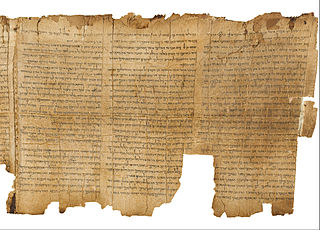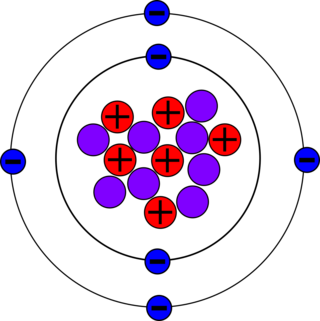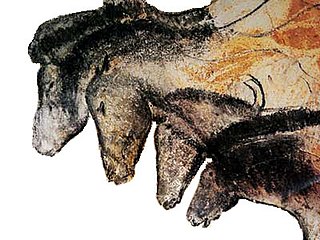Related Research Articles

Radiocarbon dating is a method for determining the age of an object containing organic material by using the properties of radiocarbon, a radioactive isotope of carbon.

The thylacine, also commonly known as the Tasmanian tiger or Tasmanian wolf, is an extinct carnivorous marsupial that was native to the Australian mainland and the islands of Tasmania and New Guinea. The thylacine died out in New Guinea and mainland Australia around 3,600–3,200 years ago, prior to the arrival of Europeans, possibly because of the introduction of the dingo, whose earliest record dates to around the same time, but which never reached Tasmania. Prior to European settlement, around 5,000 remained in the wild on Tasmania. Beginning in the nineteenth century, they were perceived as a threat to the livestock of farmers and bounty hunting was introduced. The last known of its species died in 1936 at Hobart Zoo in Tasmania. The thylacine is widespread in popular culture and is a cultural icon in Australia.

Carbon-14, C-14, 14C or radiocarbon, is a radioactive isotope of carbon with an atomic nucleus containing 6 protons and 8 neutrons. Its presence in organic matter is the basis of the radiocarbon dating method pioneered by Willard Libby and colleagues (1949) to date archaeological, geological and hydrogeological samples. Carbon-14 was discovered on February 27, 1940, by Martin Kamen and Sam Ruben at the University of California Radiation Laboratory in Berkeley, California. Its existence had been suggested by Franz Kurie in 1934.

The Chauvet-Pont-d'Arc Cave in the Ardèche department of southeastern France is a cave that contains some of the best-preserved figurative cave paintings in the world, as well as other evidence of Upper Paleolithic life. It is located near the commune of Vallon-Pont-d'Arc on a limestone cliff above the former bed of the river Ardèche, in the Gorges de l'Ardèche.
Aldo Massola was an Italian-Australian anthropologist, a curator at the National Museum of Victoria in Melbourne from 1954 to 1964, who overcame scandal in his personal life to author a number of influential books about Aboriginal Victorians.

The Tasmanian pygmy possum, also known as the little pygmy possum or tiny pygmy possum, is the world's smallest possum. It was first described by Oldfield Thomas in 1888, after he identified that a museum specimen labelled as an eastern pygmy possum in fact represented a species then unknown to science. The holotype resides in the Natural History Museum in London.
Rhys Maengwyn Jones was a Welsh-Australian archeologist.
Devil's Lair is a single-chamber cave with a floor area of around 200 m2 (2,200 sq ft) that formed in a Quaternary dune limestone of the Leeuwin–Naturaliste Ridge, 5 km (3.1 mi) from the modern coastline of Western Australia. The stratigraphic sequence in the cave floor deposit consists of 660 cm (260 in) of sandy sediments, with more than 100 distinct layers, intercalated with flowstone and other indurated deposits. Excavations have been made in several areas of the cave floor. Since 1973, excavations have been concentrated in the middle of the cave, where 10 trenches have been dug. Archaeological evidence for intermittent human occupation extends down about 350 cm (140 in) to layer 30, with hearths, bone, and stone artefacts found throughout. The site provides evidence of human habitation of Southwest Australia 50,000 years before the present day.
Oxidizable carbon ratio dating is a method of dating in archaeology and earth science that can be used to derive or estimate the age of soil and sediment samples up to 35,000 years old. The method is experimental, and it is not as widely used in archaeology as other chronometric methods such as radiocarbon dating.

The Shroud of Turin, a linen cloth that tradition associates with the crucifixion and burial of Jesus, has undergone numerous scientific tests, the most notable of which is radiocarbon dating, in an attempt to determine the relic's authenticity. In 1988, scientists at three separate laboratories dated samples from the Shroud to a range of 1260–1390 CE, which coincides with the first certain appearance of the shroud in the 1350s and is much later than the burial of Jesus in 30 or 33 CE. Aspects of the 1988 test continue to be debated. Despite some technical concerns that have been raised about radiocarbon dating of the Shroud, no radiocarbon-dating expert has asserted that the dating is substantially unreliable.
Carbon dating the Dead Sea Scrolls refers to a series of radiocarbon dating tests performed on the Dead Sea Scrolls, first by the AMS lab of the Zurich Institute of Technology in 1991 and then by the AMS Facility at the University of Arizona in Tucson in 1994–95. There was also a historical test of a piece of linen performed in 1946 by Willard Libby, the inventor of the dating method.
Derek John Mulvaney, known as John Mulvaney and D. J. Mulvaney, was an Australian archaeologist. He was the first qualified archaeologist to focus his work on Australia.
Thomas Athol Rafter was a New Zealand nuclear chemist.
Sandor (Alexander) Gallus was a Melbourne archaeologist, most famous for his investigations of Pleistocene Aboriginal occupation at Koonalda Cave in South Australia and the Dry Creek archaeological site in Keilor, Australia, which helped demonstrate the great antiquity of Aboriginal occupation of Australia.
Harry Lourandos is an Australian archaeologist, adjunct professor in the Department of Anthropology, Archaeology and Sociology, School of Arts and Social Sciences at James Cook University, Cairns. He is a leading proponent of the theory that a period of hunter-gatherer intensification occurred between 3000 and 1000 BCE.
The calculation of radiocarbon dates determines the age of an object containing organic material by using the properties of radiocarbon, a radioactive isotope of carbon.
Elizabeth K. Ralph (1921–1993) was a pioneer in the development and application of radiocarbon dating techniques to archeology, as well as a long-time member of the U.S. women's field hockey team. In the Radiocarbon Laboratory at the University of Pennsylvania, and later in the Museum Applied Science Center for Archaeology (MASCA) in the Penn Museum, Ralph developed methods for dendrochronology, or tree-ring dating, and thermoluminescence for dating ceramics. She also improved instruments for the measurement of magnetic intensity, including cesium magnetometers, which located landscape anomalies that could signal the presence of archaeological sites. In the 1960s, she used these instruments to help locate the Archaic Greek site of Sybaris in southern Italy. She went on to analyze and date materials from dozens of archaeological sites in several countries. She published her research in journals including Science and Nature, and with her colleague H.N. Michael, published a textbook entitled Dating Techniques for the Archaeologist, which appeared from MIT Press in 1971. From 1962 to 1982 she served as associate director of MASCA lab, which she helped to establish with support from the National Science Foundation.
Isabel Joy Bear was an Australian chemist who worked at CSIRO for over forty years. She was the first woman to be awarded the Royal Australian Chemical Institute Leighton Medal. She was inducted into the Victorian Honour Roll of Women in 2005. Bear identified several metastable zirconium sulphate hydrates, and with Dick Thomas was the first to scientifically describe "petrichor", the smell of rain on dry soil.
Graeme Lloyd Pretty was an Australian anthropologist. Working at the South Australian Museum for over three decades, he worked with and studied many peoples, reaching almost every continent. Pretty assisted in the largest salvaging of ethnographic materials at the time in Papua New Guinea. His work curating and preserving cultural objects stretched beyond his tenure at the South Australian Museum; he worked as a researcher for the South Australian Museum and was a visiting fellow in the Department of Anatomical Sciences at the University of Adelaide. He is considered a "principal figure" in developing the professional field of archaeology in Australia.
References
- ↑ Dating at the Museum of Applied Science Victoria 1952–70: a Pioneer Venture', January 2018 Historical Records of Australian Science 29(1) DOI: 10.1071/HR17019
- ↑ "Bermingham, Anne - Biographical entry - Encyclopedia of Australian Science". www.eoas.info. Retrieved 22 January 2021.
- 1 2 3 4 McGrath, Nik; French, Robert. "Anne Bermingham, a scientific pioneer of radiocarbon dating". Museums Victoria.
- ↑ Helen Cohn, 'Anne Birmingham biography', Encyclopedia of Australian Science Created: 26 June 2018, Last modified: 3 July 2018
- ↑ Anne Bermingham, 'Victoria Natural Radiocarbon Measurements I', Radiocarbon, VOL. 8, 1966, P. 507-521, Institute of Applied Science of Victoria, Melbourne
- ↑ Rae, Ian D. Letter from Melbourne: Old and new carbon [online]. Chemistry in Australia, Apr 2018: 41. ISSN 0314-4240
- ↑ Papers of John Mulvaney, National Library of Australia MS 9615, MS Acc13.203, MS Acc17.018, MS Acc17.088
- ↑ [file:///Users/garyvines/Downloads/b13545711.pdf R. V. S. Wright, The Archaeology of Koonalda Cave, in Aboriginal Man and Environment in Australia Ed D. J. Mulvaney and J. Golson Australian National University Press Canberra 1971, p.110]
- ↑ [file:///Users/garyvines/Downloads/ROCKY_CAPE_AND_THE_PROBLEM_OF_THE_TASMANIANS_VOL_1.pdf Rhys Jones, Rocky Cape and the Problem of the Tasmanians PhD Thesis, University of Sydney, December 1971]
- ↑ Historical Records of Australian Science 29(1) 14-27 https://doi.org/10.1071/HR17019 Published: 19 January 2018
- ↑ A Guide to the Department of Museum Studies by D, Wayne Orchiston Department of Museum Studies, Prahran College of Advanced Education, Melbourne
- ↑ 'Anne Bermingham Obituary', Herald Sun 19 August 2006